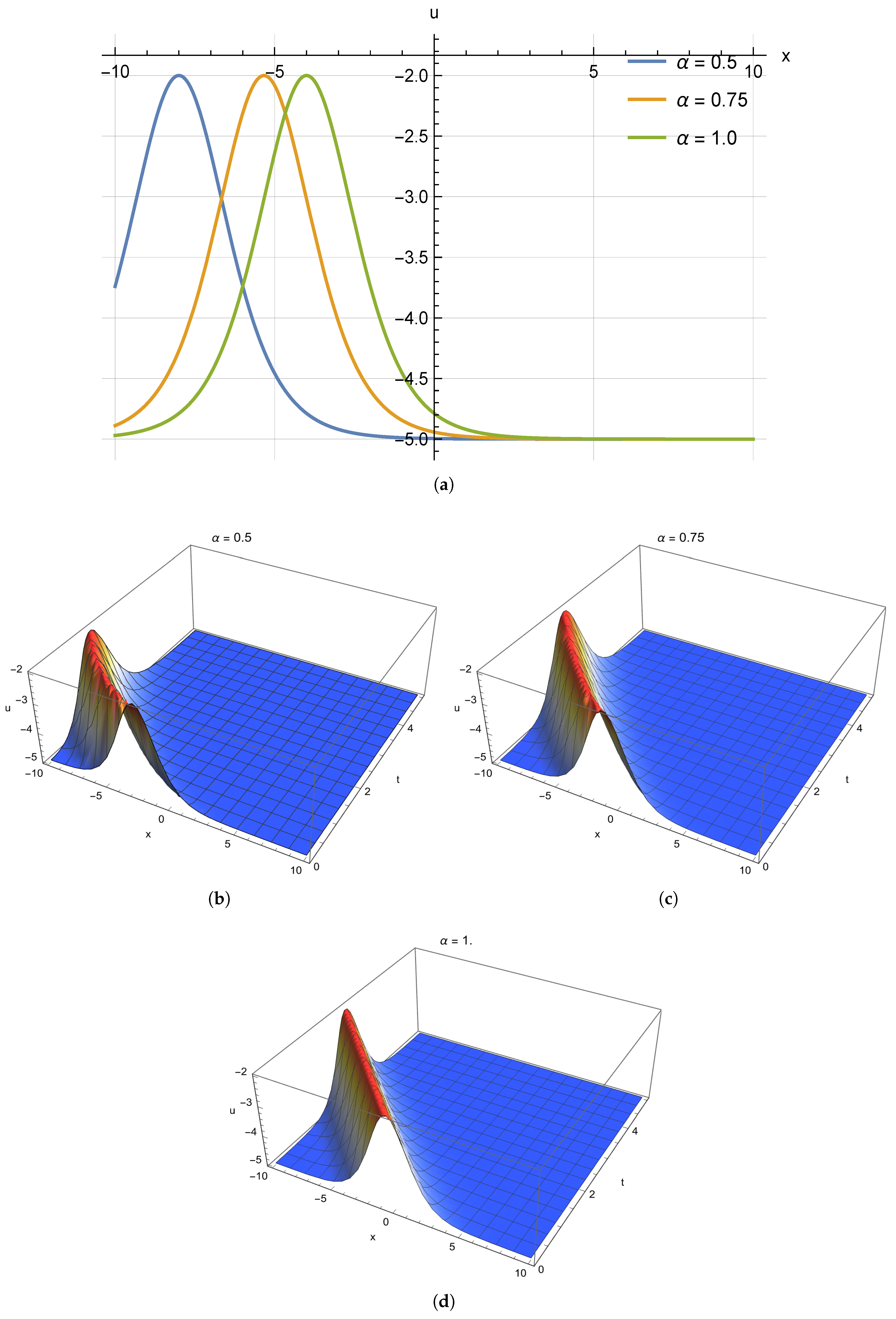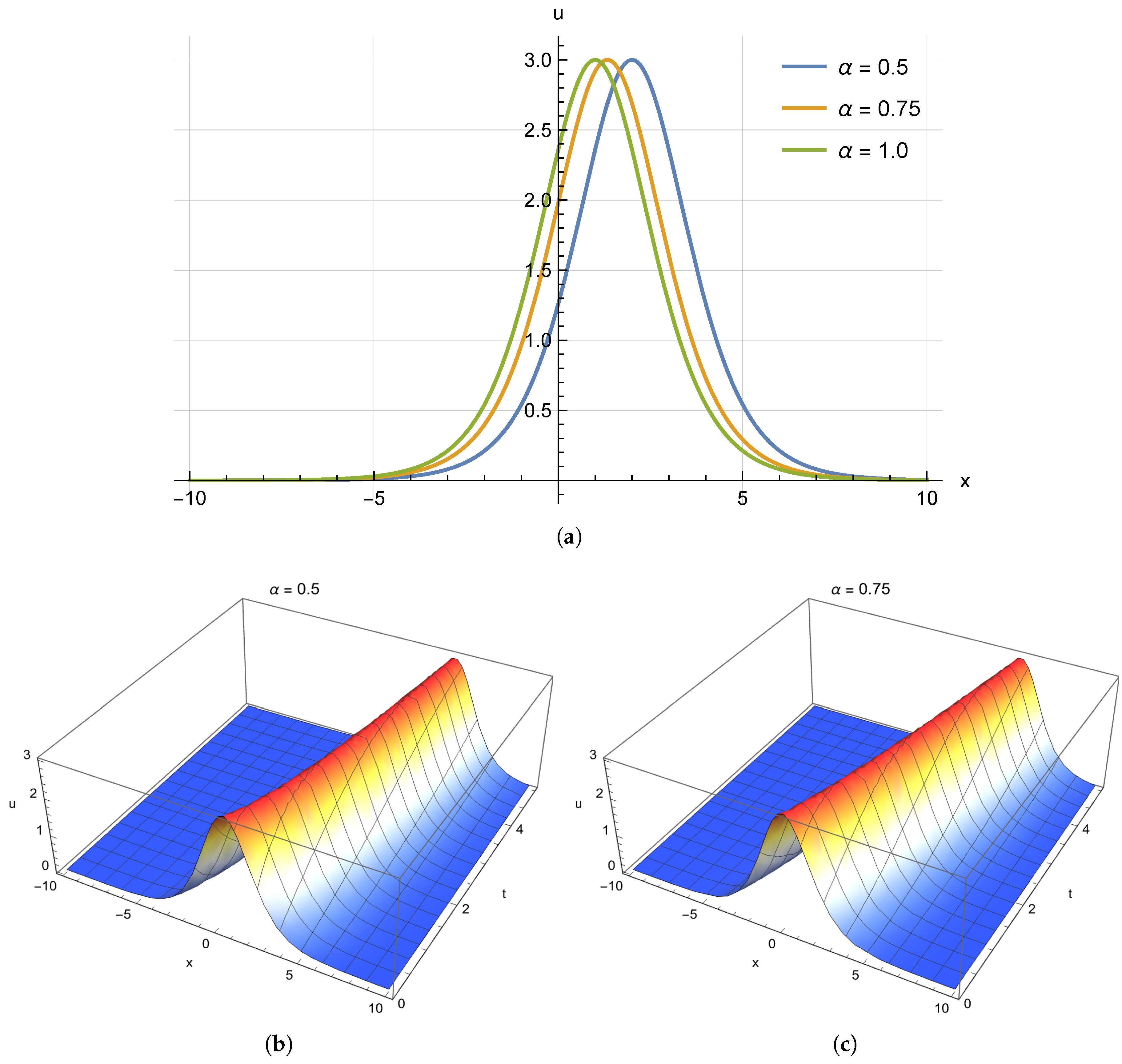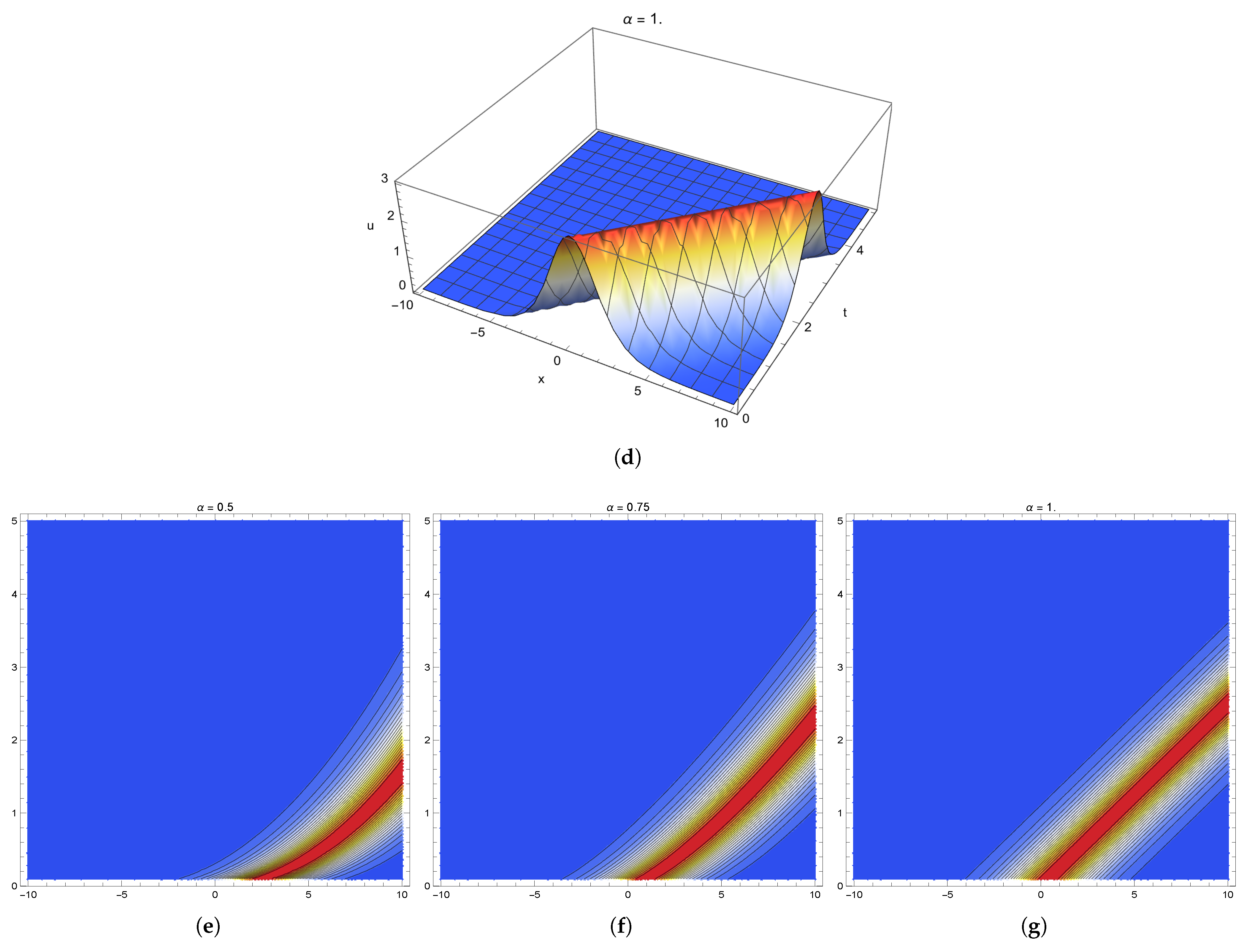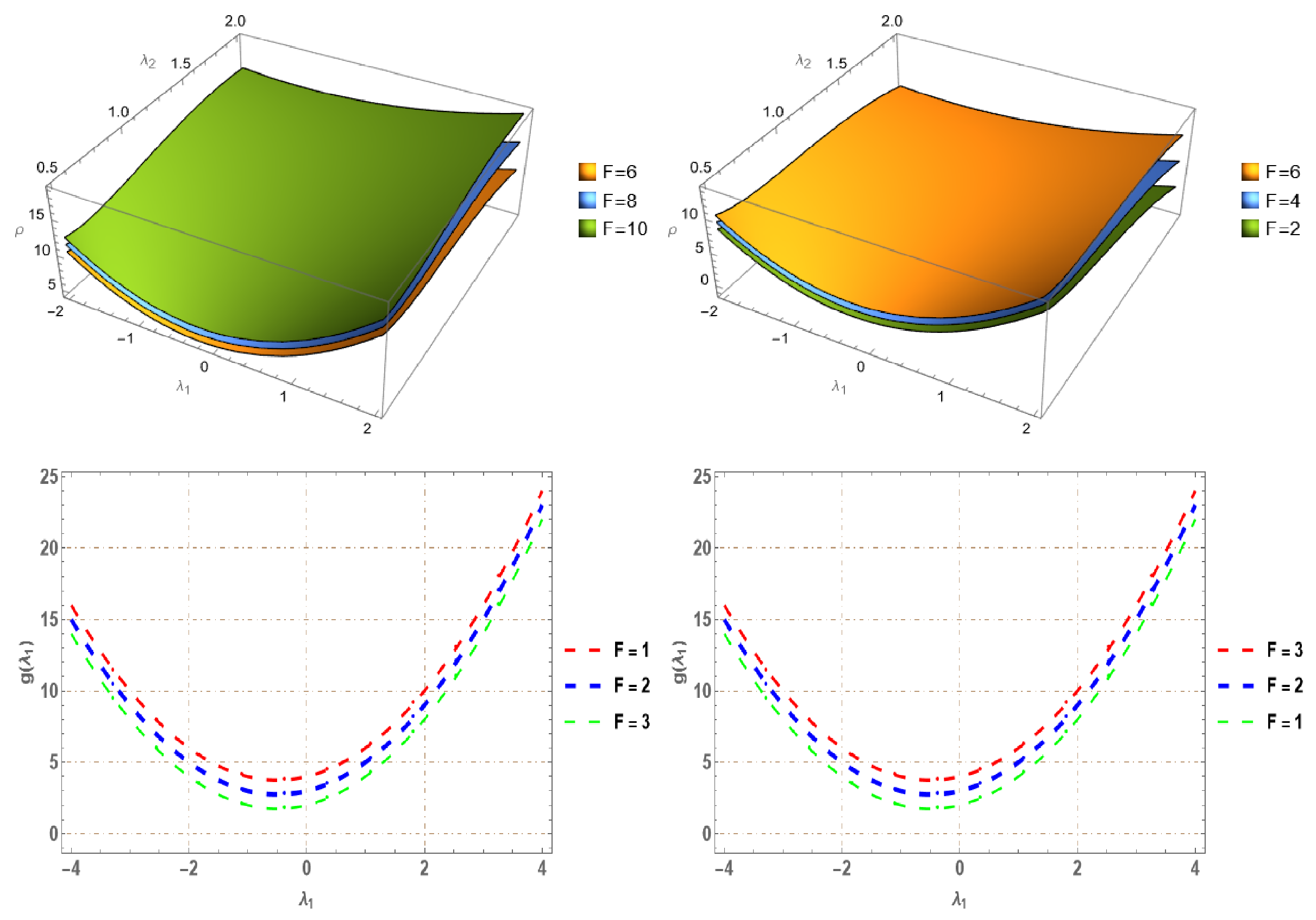Soliton Dynamics and Modulation Instability in the (3+1)-Dimensional Generalized Fractional Kadomtsev–Petviashvili Equation
Abstract
1. Introduction
2. Preliminaries
2.1. Some Useful Properties of the Beta Derivative
2.2. Background Information
3. Proposed Methods
3.1. Generalized Kudryashov Technique
3.2. Exponential Rational Function Technique
4. Main Results
4.1. Algorithm of Generalized Kudryashov Technique
4.2. Algorithm of Exponential Rational Function Technique
4.3. Modulation Instability
5. Discussion and Conclusions
Author Contributions
Funding
Data Availability Statement
Conflicts of Interest
References
- Oldham, K.B.; Spanier, F. The Fractional Calculus; Academic Press: New York, NY, USA, 1974. [Google Scholar]
- Podlubny, I. Fractional Differential Equations; Academic Press: San Diego, CA, USA, 1999. [Google Scholar]
- Mechee, M.S.; Salman, Z.I.; Alkufi, S.Y. Novel Definitions of Fractional Integral and Derivative of the Functions. Iraqi J. Sci. 2023, 64, 5866–5877. [Google Scholar] [CrossRef]
- Khalil, R.; Horani, M.A.; Yousef, A.; Sababheh, M. A new definition of fractional derivative. J. Comput. Appl. Math. 2014, 264, 65–70. [Google Scholar] [CrossRef]
- Zheng, Z.; Zhao, W.; Dai, H. A new definition of fractional derivative. Int. J. Non-Linear Mech. 2019, 108, 16. [Google Scholar] [CrossRef]
- Miller, K.S.; Ross, B. An Introduction to the Fractional Calculus and Fractional Differential Equations; Wiley: New York, NY, USA, 1993. [Google Scholar]
- Kilbas, A.A.; Srivastava, H.M.; Trujillo, J.J. Theory and Applications of Fractional Differential Equations; Elsevier: Amsterdam, The Netherlands, 2006. [Google Scholar]
- Rezazadeh, H.; Zabihi, A.; Davodi, A.G.; Ansari, R.; Ahmad, H.; Yao, S.W. New optical solitons of double Sine-Gordon equation using exact solutions methods. Results Phys. 2023, 49, 106452. [Google Scholar] [CrossRef]
- Ismael, H.F.; Seadawy, A.; Bulut, H. Multiple soliton, fusion, breather, lump, mixed kink-lump and periodic solutions to the extended shallow water wave model in (2+1)-dimensions. Mod. Phys. Lett. B 2021, 35, 2150138. [Google Scholar] [CrossRef]
- Eslami, M.; Vajargah, B.F.; Mirzazadeh, M.; Biswas, A. Application of first integral method to fractional partial differential equations. Indian J. Phys. 2014, 88, 177–184. [Google Scholar] [CrossRef]
- Zhang, S.; Zhang, H.Q. Fractional sub-equation method and its applications to nonlinear fractional PDEs. Phys. Lett. A 2011, 375, 1069–1073. [Google Scholar] [CrossRef]
- Arshed, S.; Raza, N.; Butt, A.R.; Akgül, A. Exact solutions for Kraenkel-Manna-Merle model in saturated ferromagnetic materials using β-derivative. Phys. Scr. 2021, 96, 124018. [Google Scholar] [CrossRef]
- Cortez, M.V.; Farooq, F.B.; Raza, N.; Alqahtani, N.A.; Nazir, M.I.T. A comprehensive study of wave dynamics in the (4+1)-dimensional space-time fractional Fokas model arising in physical sciences. Alex. Eng. J. 2025, 115, 238–251. [Google Scholar] [CrossRef]
- Butt, A.R.; Zaka, J.; Akgül, A.; El Din, S.M. New structures for exact solution of nonlinear fractional Sharma-Tasso-Olver equation by conformable fractional derivative. Results Phys. 2023, 50, 10654. [Google Scholar] [CrossRef]
- Ismael, H.F.; Bulut, H.; Baskonus, H.M.; Gao, W. Newly modified method and its application to the coupled Boussinesq equation in ocean engineering with its linear stability analysis. Commun. Theor. Phys. 2020, 72, 115002. [Google Scholar] [CrossRef]
- Hosseini, K.; Ansari, R. New exact solutions of nonlinear conformable time-fractional Boussinesq equations using the modified Kudryashov method. Waves Random Complex Media 2017, 27, 628–636. [Google Scholar] [CrossRef]
- Ghanbari, B.; Baleanu, D. A novel technique to construct exact solutions for nonlinear partial differential equations. Eur. Phys. J. Plus 2019, 134, 506. [Google Scholar] [CrossRef]
- Bulut, H.; Baskonus, H.M.; Pandir, Y. The modified trial equation method for fractional wave equation and time fractional generalized Burgers equation. Abstr. Appl. Anal. 2013, 2013, 636802. [Google Scholar] [CrossRef]
- Kaplan, M.; Bekir, A.; Akbulut, A.; Aksoy, E. The modified simple equation method for nonlinear fractional differential equations. Rom. J. Phys. 2014, 60, 1374–1383. [Google Scholar]
- Ismael, H.F.; Ma, W.X.; Bulut, H. Dynamics of soliton and mixed lump-soliton waves to a generalized Bogoyavlensky-Konopelchenko equation. Phys. Scr. 2021, 96, 035225. [Google Scholar] [CrossRef]
- Ismael, H.F.; Sulaiman, T.A.; Osman, M.S. Multi-solutions with specific geometrical wave structures to a nonlinear evolution equation in the presence of the linear superposition principle. Commun. Theor. Phys. 2022, 75, 015001. [Google Scholar] [CrossRef]
- Onder, I.; Secer, A.; Bayram, M. Soliton solutions of time-fractional modified Korteweg-de-Vries Zakharov-Kuznetsov equation and modulation instability analysis. Phys. Scr. 2024, 99, 015213. [Google Scholar] [CrossRef]
- Wu, G.; Guo, Y.; Yu, Y. Exploring New Traveling Wave Solutions for the Spatiotemporal Evolution of a Special Reaction-Diffusion Equation by Extended Riccati Equation Method. Symmetry 2024, 16, 1106. [Google Scholar] [CrossRef]
- Ismael, H.F.; Atas, S.S.; Bulut, H.; Osman, M.S. Analytical solutions to the M-derivative resonant Davey-Stewartson equations. Mod. Phys. Lett. B 2021, 35, 2150455. [Google Scholar] [CrossRef]
- Raza, N.; Deifalla, A.; Rani, B.; Shah, N.A.; Ragab, A.E. Analyzing Soliton Solutions of the (n + 1)-dimensional generalized Kadomtsev-Petviashvili equation: Comprehensive study of dark, bright, and periodic dynamics. Results Phys. 2024, 56, 107224. [Google Scholar] [CrossRef]
- Xu, G.Q.; Wazwaz, A.M. A new (n+1)-dimensional generalized Kadomtsev-Petviashvili equation: Integrability characteristics and localized solutions. Nonlinear Dyn. 2023, 111, 9495–9507. [Google Scholar] [CrossRef]
- Hong, B.; Wang, J. Exact Solutions for the Generalized Atangana-Baleanu-Riemann Fractional (3+1)-Dimensional Kadomtsev-Petviashvili Equation. Symmetry 2023, 15, 3. [Google Scholar] [CrossRef]
- Mohammed, K. New exact traveling wave solutions of the (3+1)-dimensional Kadomtsev-Petviashvili (KP) equation. Commun. Nonlinear Sci. Numer. Simul. 2009, 14, 1169–1175. [Google Scholar]
- Ma, W.X.; Zhu, Z.N. Solving the (3+1)-dimensional generalized KP and BKP equations by the multiple exp-function algorithm. Appl. Math. Comput. 2012, 218, 11871–11879. [Google Scholar] [CrossRef]
- Hao, X.Z.; Liu, Y.P.; Li, Z.B.; Ma, W.X. Painlevé analysis, soliton solutions and lump-type solutions of the (3+1)-dimensional generalized KP equation. Comput. Math. Appl. 2019, 77, 724–730. [Google Scholar] [CrossRef]
- Baleanu, D.; Guvenc, Z.B.; Machado, J.A.T. New Trends in Nanotechnology and Fractional Calculus Applications; Springer: Berlin/Heidelberg, Germany, 2010. [Google Scholar]
- Kudryashov, N.A. Solitary and periodic waves of the hierarchy for propagation pulse in optical fiber. Optik 2019, 194, 163060. [Google Scholar] [CrossRef]
- Kudryashov, N.A. One method for finding exact solutions of nonlinear differential equations. Commun. Nonlinear Sci. Numer. Simul. 2012, 17, 2248–2253. [Google Scholar] [CrossRef]
- Bekir, A.; Kaplan, M. Exponential rational function method for solving nonlinear equations arising in various physical models. Chin. J. Phys. 2016, 54, 365–370. [Google Scholar] [CrossRef]
- Rahman, R.U.; Al-Maaitahb, A.F.; Qousinic, M.; Az-Zo’bid, E.A.; Eldine, S.M.; Abuzar, M. Nonlinear solutions and modulation instability analysis of fractional Huxley equation. Results Phys. 2023, 44, 106163. [Google Scholar] [CrossRef]
- Elboree, M.K. Lump solitons, rogue wave solutions and lump-stripe interaction phenomena to an extended (3+1)-dimensional KP equation. Chin. J. Phys. 2020, 63, 290–303. [Google Scholar] [CrossRef]
- Wazwaz, A.M.; El-Tantawy, S.A.E. Solving the (3+1)-dimensional KP Boussinesq and BKP-Boussinesq equations by the simplified Hirota method. Nonlinear Dyn. 2017, 88, 3017–3021. [Google Scholar] [CrossRef]






Disclaimer/Publisher’s Note: The statements, opinions and data contained in all publications are solely those of the individual author(s) and contributor(s) and not of MDPI and/or the editor(s). MDPI and/or the editor(s) disclaim responsibility for any injury to people or property resulting from any ideas, methods, instructions or products referred to in the content. |
© 2025 by the authors. Licensee MDPI, Basel, Switzerland. This article is an open access article distributed under the terms and conditions of the Creative Commons Attribution (CC BY) license (https://creativecommons.org/licenses/by/4.0/).
Share and Cite
Alharthi, N.H.; Kaplan, M.; Alqahtani, R.T. Soliton Dynamics and Modulation Instability in the (3+1)-Dimensional Generalized Fractional Kadomtsev–Petviashvili Equation. Symmetry 2025, 17, 666. https://doi.org/10.3390/sym17050666
Alharthi NH, Kaplan M, Alqahtani RT. Soliton Dynamics and Modulation Instability in the (3+1)-Dimensional Generalized Fractional Kadomtsev–Petviashvili Equation. Symmetry. 2025; 17(5):666. https://doi.org/10.3390/sym17050666
Chicago/Turabian StyleAlharthi, Nadiyah Hussain, Melike Kaplan, and Rubayyi T. Alqahtani. 2025. "Soliton Dynamics and Modulation Instability in the (3+1)-Dimensional Generalized Fractional Kadomtsev–Petviashvili Equation" Symmetry 17, no. 5: 666. https://doi.org/10.3390/sym17050666
APA StyleAlharthi, N. H., Kaplan, M., & Alqahtani, R. T. (2025). Soliton Dynamics and Modulation Instability in the (3+1)-Dimensional Generalized Fractional Kadomtsev–Petviashvili Equation. Symmetry, 17(5), 666. https://doi.org/10.3390/sym17050666






